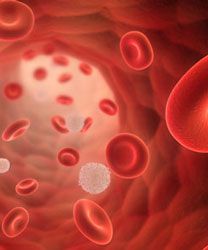Pixantrone Fails to Prolong PFS in Phase III B-Cell NHL Trial
Progression-free survival was not improved by combining pixantrone with rituximab compared with gemcitabine plus rituximab in patients with aggressive B-cell non-Hodgkin lymphoma enrolled in the phase III PIX306 trial, according to CTI BioPharma, the manufacturer of pixantrone.
blood cells

Progression-free survival was not improved by combining pixantrone (Pixuvri) with rituximab (Rituxan) compared with gemcitabine plus rituximab in patients with aggressive B-cell non-Hodgkin lymphoma (NHL) enrolled in the phase III PIX306 trial, according to CTI BioPharma, the manufacturer of pixantrone.
The study included 312 previously treated patients who had received CHOP-R or equivalent treatment and relapsed. Individuals were not eligible for stem cell transplant. Beyond the primary PFS endpoint, secondary outcome measures included overall survival (OS), overall response rate (ORR), complete response rate, and safety. CTI did not report any specific data, but intends to submit the PIX306 findings for publication in a peer-reviewed journal.
"We are disappointed with the outcome of the PIX306 trial and will proceed to conduct a thorough review of clinical data to assess the next steps for the Pixuvri program," Adam Craig, MD, PhD, CEO of CTI BioPharma, said in a statement. "We would like to express our appreciation to the patients, families, and investigators who participated in the study."
In 2012, pixantrone was approved in the European Union for single-agent use as a treatment for patients with relapsed/refractory, aggressive B-cell NHL. However, pixantrone has no approved indications in the United States.
In June 2009, CTI completed a submission of a new drug application (NDA) to the FDA for pixantrone monotherapy as a treatment for patients with relapsed/refractory, aggressive NHL. The NDA was based on the phase III PIX301 EXTEND trial, which compared pixantrone with other chemotherapeutic agents in the third-line setting for patients with relapsed, aggressive NHL.
In the primary analysis of EXTEND, pixantrone was shown to significantly (P= .02) improve the rate of patients achieving a confirmed (CR) or unconfirmed (CRu) complete remission compared with standard chemotherapy.1The CR/CRu rates were 20.0% (14/70) versus 5.7% (4/70). The CR rate was 11% with pixantrone versus 0% in the control arm.
Patients receiving pixantrone also had a significant improvement in ORR at 37.1% (26/70) versus 14.3% (10/70) with standard chemotherapy (P= .003). The median PFS rates were 4.7 versus 2.6 months, respectively (P= .007)
The most frequently reported grade 3/4 adverse event (AE) with pixantrone was neutropenia at 41.2% compared with 19.4% in the control arm. The rates of grade 3/4 febrile neutropenia were 7.4% versus 3.0%, respectively, and grade 3/4 infections occurred at 18% versus 13%, respectively. There was also a higher rate of cardiac toxicities with pixantrone at 8.8% versus 4.5% in the control arm.
Longer follow-up for EXTEND at 18 months continued to show improved efficacy with pixantrone versus standard chemotherapy. The CR/CRu rates were 25.7% versus 7.1% (P= .005) and the ORR rates were 40.0% versus 14.3% (P= .001), respectively.2 The median PFS was 5.6 versus 2.6 months (HR, 0.56;P= .002) and the median OS was 10.2 versus 6.9 months, respectively (HR, 0.82;P= .3).
In March 2010, however, the FDA’s Oncologic Drugs Advisory Committee (ODAC) voted unanimously that the clinical trial findings were not sufficient to support approval of the NDA for single-agent pixantrone in relapsed/refractory NHL. The FDA followed the committee’s recommendation and sent a complete response letter (CRL) to CTI in April 2010, citing the concerns of the ODAC panel and recommending the initiation of an additional clinical trial to support the drug’s efficacy and safety.
CTI did not conduct an additional trial at the time. The company instead appealed the CRL and provided additional analysis of the EXTEND findings with its resubmission of its NDA to the FDA in October 2011. A second ODAC meeting was then set for February 9, 2012, to review CTI’s resubmitted NDA. However, on January 30, 2012, CTI announced that it had withdrawn its NDA after the FDA did not meet its request to reschedule the ODAC meeting to late March 2012.
References:
- Cell Therapeutics Completes Pixantrone NDA Submission and Requests Priority Review. Published June 24, 2009. Accessed July 9, 2018. https://bit.ly/2u7Ab6V.
- 18-month Follow-up Data on Phase III Study of Pixantrone in Late Stage Relapsed or Refractory, Aggressive Non-Hodgkin's Lymphoma Continues to Demonstrate Significant Improvement in Complete Remission and Progression Free Survival Over Standard Chemotherapy. Published September 16, 2009. Accessed July 9, 2018. https://bit.ly/2m2TJFd
Examining the Non-Hodgkin Lymphoma Treatment Paradigm
July 15th 2022In season 3, episode 6 of Targeted Talks, Yazan Samhouri, MD, discusses the exciting new agents for the treatment of non-Hodgkin lymphoma, the clinical trials that support their use, and hopes for the future of treatment.
Listen